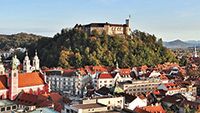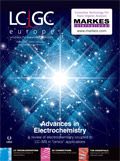Event: 21st International Symposium on Separation Sciences (21st ISSS 2015)
Event: 21st International Symposium on Separation Sceinces (21st ISSS 2015)
The 21st International Symposium on Separation Sciences (ISSS) will be held at the Grand Hotel Union in Ljubljana, Slovenia, from 30 June–3 July 2015. The ISSS holds a long and successful tradition of engaging the international community in all areas of separation science. What started out as a biennial meeting of Slovenian and Croatian separation scientists, first held in Slovenia in 1990, has grown into a world-class international event.

(PHOTO CREDIT: PHOTO COURTESY OF IRENA VOVK)
The 21st ISSS 2015 will cover new advances and challenges in all fields of separation sciences including electrophoresis; liquid, gas, and thin-layer chromatography and hyphenated techniques thereof; sample preparation, chemometrics; and validation. The scientific programme will encompass the fundamentals of separation sciences, advances in detection methods, multidimensional techniques, applications, life sciences, metabolomics and biomarker discovery, and natural and synthetic polymers. Separation science has a prominent place in modern analytical chemistry and is globally becoming more and more important in daily life. Several renowned keynote speakers have already agreed to participate: Pat Sandra (Research Institute for Chromatography, Belgium), František Švec (Lawrence Berkeley National Laboratory, California, USA), Peter Schoenmakers (University of Amsterdam, The Netherlands), Colin Poole (Wayne State University, Michigan, USA), Boguslaw Buszewski (Nicolas Copernicus University, Poland), Danilo Corradini (Institute of Chemical Methodologies, Italy), Attila Felinger (University of Pécs, Hungary), Pavel Jandera (University of Pardubice, Czech Republic), Dušan Berek (Polymer Institute, Slovak Academy of Science, Slovakia), Tomislav BolanÄa (University of Zagreb, Croatia), Virginia Coman (Babes-Bolyai University, Romania), Imre Klebovich (Semmelweis University, Hungary), Modest Gertsiuk (Institute of Environmental Geochemistry, Ukraine), Doo Soo Chung (Seoul National University, Korea), and Mirek Macka (University of Tasmania, Australia).
The programme will consist of invited lectures, oral presentations, and poster presentations. All poster presentations will also enter a Best Poster Award competition. The presenting author of the winning poster will be awarded with free participation at the 22nd ISSS 2016. In addition, the Central European Group for Separation Sciences Awards will be presented in recognition of important contributions to the development of separation science. The exhibition will form an integral part of the symposium and will be located in the venue halls. Every year, the vision of ISSS is strongly supported by multiple key sponsors and exhibitors, who are also given an unique opportunity to build trust, enhance credibility, and promote brand awareness and recognition.
The ISSS series has historically been an excellent means for young researchers to expand their knowledge about state-of-the-art methods and approaches used in separation sciences. Attractive and rich social programmes will create the perfect atmosphere to connect with old acquaintances and build long-lasting friendships that may blossom into fruitful joint adventures. In the course of the event, the organizers of 21st ISSS 2015 endeavour to inspire future research, innovation, and scientific collaboration as well as offer the participants a taste of Slovenia's natural beauty, intriguing history, culture, and cuisine.
Chair: Dr. Irena Vovk • E-mail: info@isss2015.si • Website: www.isss2015.si
17–21 May 201539th International Symposium on Capillary Chromatography (ISCC) and 12th GC×GC Symposium 2015
Ft. Worth, Texas, USA
E-mail:info@isccgcxgc2015.comWebsite:www.isccgcxgc2015.com
21–25 June 2015 42nd International Symposium on High Performance Liquid Phase Separations and Related Techniques (HPLC 2015)
International Conference Centre, Geneva, Switzerland
Tel: +41 22 839 84 84
E-mail: chairman@hplc2015.orgWebsite: www.hplc2015-Geneva.org
28 June–1 July 2015Recent Developments in Pharmaceutical Analysis (RDPA 2015)
University of Perugia, Perugia, Italy
Tel: +39 0755855131
E-mail: symposium@rdpa2015.comWebsite: rdpa2015.chimfarm.unipg.it
3–6 November 2015Recent Advances in Food Analysis (RAFA)
Clarion Congress Hotel, Prague, Czech Republic
Tel:+386 1 4760 265
E-mail:rafa2015@vscht.cz.
Website:www.rafa2015.eu
18–19 November 2015PEFTEC International Conference and Exhibition for Petrochemical Analysis
Antwerp Exhibition Centre, Antwerp, Belgium
Tel: +44 1727 858840
E-mail: info@peftec.comWebsite:www.peftec.com
Please send any event news to Bethany Degg bdegg@advanstar.com

Free Poster: NDSRI Risk Assessment and Trace-Level Analysis of N-Nitrosamines
April 25th 2025With increasing concern over genotoxic nitrosamine contaminants, regulatory bodies like the FDA and EMA have introduced strict guidelines following several high-profile drug recalls. This poster showcases a case study where LGC and Waters developed a UPLC/MS/MS method for quantifying trace levels of N-nitroso-sertraline in sertraline using Waters mass spectrometry and LGC reference standards.
New Guide: Characterising Impurity Standards – What Defines “Good Enough?”
April 25th 2025Impurity reference standards (IRSs) are essential for accurately identifying and quantifying impurities in pharmaceutical development and manufacturing. Yet, with limited regulatory guidance on how much characterisation is truly required for different applications, selecting the right standard can be challenging. To help, LGC has developed a new interactive multimedia guide, packed with expert insights to support your decision-making and give you greater confidence when choosing the right IRS for your specific needs.
Using the Carcinogenic Potency Categorisation Approach (CPCA) to Classify N-nitrosamine Impurities
April 25th 2025Learn how to manage nitrosamine impurities in pharmaceuticals with our free infographic. Discover how the CPCA approach establishes acceptable intake limits and guides the selection of NDSRI reference samples. Stay compliant and ensure safety with our ISO-accredited standards.

.png&w=3840&q=75)

.png&w=3840&q=75)



.png&w=3840&q=75)



.png&w=3840&q=75)









